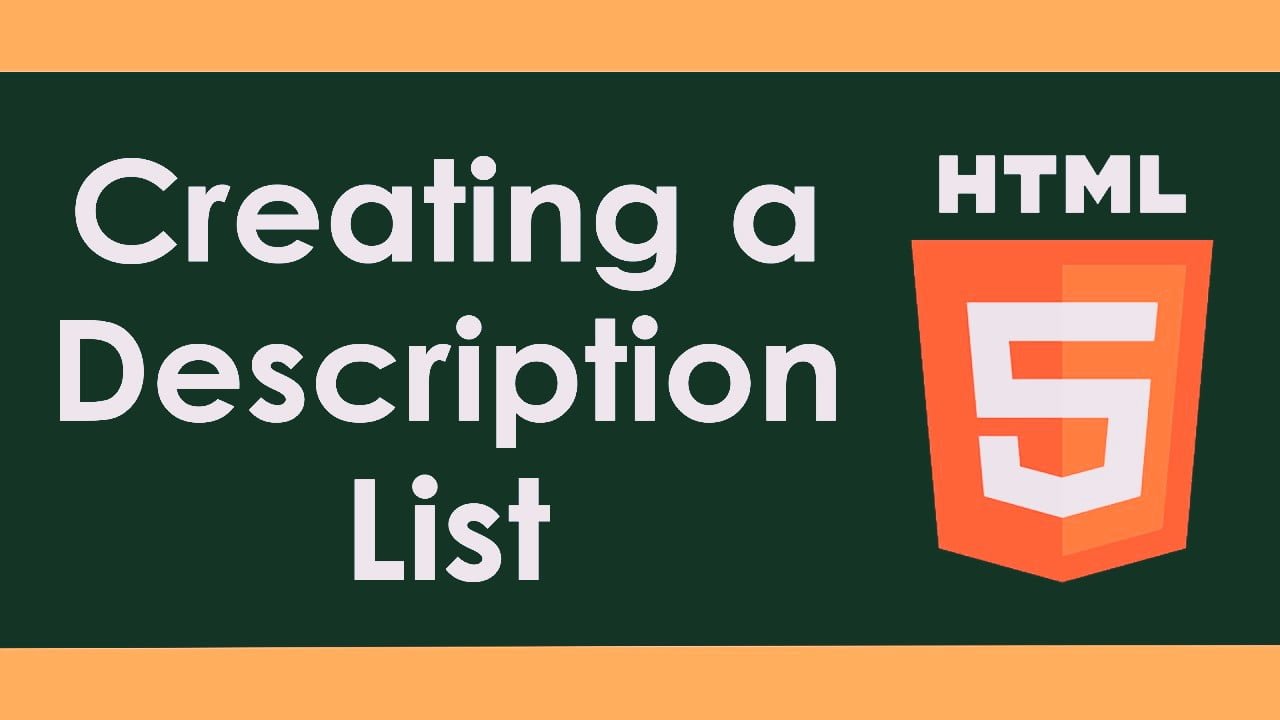HTML Tutorial
- HTML HOME
- HTML Introduction
- HTML Editors
- HTML Basics
- HTML Comments
- HTML Elements
- HTML Attributes
- HTML Headings
- HTML Paragraphs
- HTML Styles
- HTML Text Formatting
- HTML Quotations
- HTML Colors
- HTML Links
- HTML Images
- HTML Favicons: How to Add and Optimize for All Browsers
- HTML Page Title: How to Optimize Titles for SEO Success
- HTML Tables: Create & Optimize for Better Web Design | Codeezy
- HTML Lists: Types, Examples & SEO Tips for Better Structure
- HTML Block and Inline Elements
- HTML Iframes
- HTML File Paths
- HTML Layout
- HTML Computer Code Elements
- HTML Semantics
- HTML5 Semantics
- HTML Entities
- HTML Symbols
- HTML Emojis
- HTML Charsets
HTML Description Lists: Structure and Usage

The HTML <dl> tag is used to define a description list, which is a way to group terms and their corresponding descriptions. This tag works with two other tags: <dt> for defining the term and <dd> for providing the description. This format is ideal for presenting definitions, FAQs, or other term-description pairs in a structured and easy-to-read manner.
Syntax
<dl>
<dt>Term 1</dt>
<dd>Description 1</dd>
<dt>Term 2</dt>
<dd>Description 2</dd>
</dl>
Description List Tags
| Tag | Description |
|---|---|
<dl> | Defines the description list. |
<dt> | Specifies the term or name in the description list. |
<dd> | Describes the term specified by the preceding <dt>. |
Example 1: Basic Description List
In this example, we’ll create a description list that explains some core programming languages and their purposes, which is helpful for beginners on Codeezy.
<!DOCTYPE html>
<html lang="en">
<head>
<meta charset="UTF-8">
<meta name="viewport" content="width=device-width, initial-scale=1.0">
<title>Description List Example | Codeezy</title>
</head>
<body>
<h2>Core Programming Languages</h2>
<dl>
<dt>Python</dt>
<dd>A versatile language known for its simplicity and readability, widely used in web development, data science, and automation.</dd>
<dt>JavaScript</dt>
<dd>The language of the web, essential for front-end development and enabling interactive web pages.</dd>
<dt>HTML</dt>
<dd>The foundational markup language used to structure content on the web.</dd>
<dt>CSS</dt>
<dd>Used to style HTML content, making web pages visually appealing.</dd>
</dl>
</body>
</html>
Output:
- Python: A versatile language known for its simplicity and readability, widely used in web development, data science, and automation.
- JavaScript: The language of the web, essential for front-end development and enabling interactive web pages.
- HTML: The foundational markup language used to structure content on the web.
- CSS: Used to style HTML content, making web pages visually appealing.
Example 2: Nested Description List
This example demonstrates a nested description list, which could be useful on Codeezy to organize different categories of courses under a common topic.
<!DOCTYPE html>
<html lang="en">
<head>
<meta charset="UTF-8">
<meta name="viewport" content="width=device-width, initial-scale=1.0">
<title>Nested Description List Example | Codeezy</title>
</head>
<body>
<h2>Codeezy Course Categories</h2>
<dl>
<dt>Programming Languages</dt>
<dd>
<dl>
<dt>Python</dt>
<dd>Comprehensive courses from beginner to advanced levels.</dd>
<dt>JavaScript</dt>
<dd>Courses covering ES6, frameworks, and modern JavaScript development.</dd>
</dl>
</dd>
<dt>Web Development</dt>
<dd>
<dl>
<dt>HTML & CSS</dt>
<dd>Courses focused on building and styling websites.</dd>
<dt>React</dt>
<dd>Advanced courses on building dynamic single-page applications.</dd>
</dl>
</dd>
</dl>
</body>
</html>
Output:
- Programming Languages
- Python: Comprehensive courses from beginner to advanced levels.
- JavaScript: Courses covering ES6, frameworks, and modern JavaScript development.
- Web Development
- HTML & CSS: Courses focused on building and styling websites.
- React: Advanced courses on building dynamic single-page applications.
Conclusion
The <dl> tag in HTML is a powerful tool for organizing content in a way that enhances clarity and readability. Whether you’re presenting definitions, product features, or any other paired information, description lists offer a clear and structured format. By leveraging <dl>, <dt>, and <dd>, you can create content that is not only informative but also user-friendly.
HTML Description Lists – FAQs
What is the use of the
<dl>tag?- The
<dl>tag defines a description list, which is used to group terms and their corresponding descriptions.
- The
How do I use the
<dt>tag?- The
<dt>tag is used to specify a term or name in the description list. Each<dt>is followed by one or more<dd>tags that provide the term’s description.
- The
What does the
<dd>tag do?- The
<dd>tag provides the description or details for the term specified in the<dt>tag.
- The
Can description lists be nested?
- Yes, you can nest description lists by placing a
<dl>element inside a<dd>element to create hierarchical descriptions.
- Yes, you can nest description lists by placing a
Can I style description lists with CSS?
- Absolutely! You can style description lists using CSS just like any other HTML element, targeting the
<dl>,<dt>, and<dd>elements individually or collectively.
- Absolutely! You can style description lists using CSS just like any other HTML element, targeting the
Thank You for Visiting Codeezy.org!
We’re thrilled to have you as part of our coding community. Your engagement and support inspire us to continue providing high-quality resources and tools to enhance your web development journey. Whether you’re a beginner or an experienced coder, we hope you found valuable insights and tools here at Codeezy.
Stay connected for more tips, tutorials, and updates to help you code with ease. Thank you for choosing Codeezy.org—your growth as a developer is our motivation!
Happy coding!
